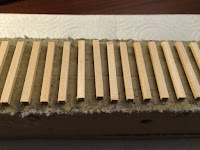This and successive postings of this title will follow the project to convert this 2-rail Atlas Trainman model of a ACF 50' boxcar lettered for the Green Bay & Western into a Proto:48 model.
The prototype is a lot (#
11-06860) of 150 50' boxcar built in June 1979 by ACF Industries.
(Transcribed ORER data at the previous link is courtesy of the Green Bay & Western Historical Society).
They were used in general service and lacked any special equipment for one of GBW's signature traffic lanes: finished rolled paper. However, quite a few other products were generated in their service area, so I should have no trouble determining a suitable lading for this car while in service on the Fairgrounds Branch.
I've only been able to find photos of these cars after they'd left GBW ownership; many were transferred to short lines, including these four that went to Hartford & Slocumb:
Serveral other photos of adjacent car series are also available: See this
reference photo and the one included below as examples of the ones built by Evans-SIECO.
The 74xx cars were slightly more populous (200 cars in the lot) and are nearly identical, except for the squared off sill plate.
Proto:48 Conversion
Here's where the fun begins. There are a few discrepancies between the prototype and the model, most notably the side sill.
Side Sill
Atlas' model appears to be a combination between the various GBW car series in what I could only describe as an attempt to please everyone. The model has a two-step sill that is full height across the door and the adjacent four panels on either side. It then steps down for one panel's width and runs about half height for one more panel length. Along the length of the outermost panel, the sill is gone and the stirrups hang directly from the body there.
The stirrups and lack of sill match the
7450-7649 series car by Evans. The angled transitions in side sill height match none of the 7xxx series cars, though having two different heights is reminiscent of the 7450-7469 series, except that the extra height reinforcement was limited to the space directly under the door. I've seen examples of the height transition being both vertical and angled.
The cars in the
7400-7450 series that were constructed around the same time by FMC have a longer side sill reinforcement spanning more of the car length, but the sill runs all the way to the end of the car.
It would be nice if the Atlas model at least represented one of the series correctly and then the recovery process would be limited to decals. Alas, some styrene and paint will be required to fix this up.
Summarizing the options:
| To Series | Positives | Negatives |
|---|
| 7000 to 7049 | Has the two-step side still | Was built by FMC |
| 7050 to 7199 |
Was built by ACF
Is lettered correctly (lot #, car #, etc.)
Has correct size door
| Need to build out side still to full length
Need to add under door reinforcement |
| 7200 to 7407 | Was built by ACF | |
| 7450 to 7649 |
Closest match for sill at car ends
Closest match for stirrups
|
Model has corner posts
Was built by Evans/SIECO
Latter half of this series was blue
|
The build out of the sill to match the 7050-7199 series car appears to actually be a combination of addition and removal. The model's current 13" side sill seems appropriate for the reinforced portion under the door (based on some crude scaling in a few prototype photos) and would need to be cut down to approximately nine inches on the rest of the car and then extended at that height to the car ends.
This seems like the smallest amount of work, so the target car series will be the one the model intended -- by the manufacturer's car numbering, at least -- the 7050 to 7199 series.
Minor Details
The only other cosmetic upgrades I can see right away would be wire grabs since in this scale, the shadow behind those should be noticeable. Plus, I already have to make new stirrups anyway.
The model has the newer "black-box" style COTS markings, but I'd have to confirm when this started to appear. Atlas populated theirs with original dates, so it may very well be correct.
Followup: Seems that this is correct.
Tony Thompson's excellent research on the SP resulted in this
rule applicability timeline, and two-panel COTS stencils were required on new cars starting in 1974.
The stenciling has the inside length off (short) by one inch. ORER data indicates 50'7".
If I get excited, I'll see if there's an easy way to make a thinner lower door track. Prototype photos show this being considerably thinner and having a shadow against the car than Atlas' representation.
Trucks and Couplers
Based on comparisons to the prototype photos, the trucks themselves look to be correctly size and proportioned. Atlas' model has rotating end caps on the roller bearings. Of course, I'll need to
narrow the bolsters (planning to use parts from
James Lincoln here) and get
replacement wheels from
Protocraft's selection. I'll probably also go with the
couplers from
Protocraft or maybe
San Juan Car Company

















































